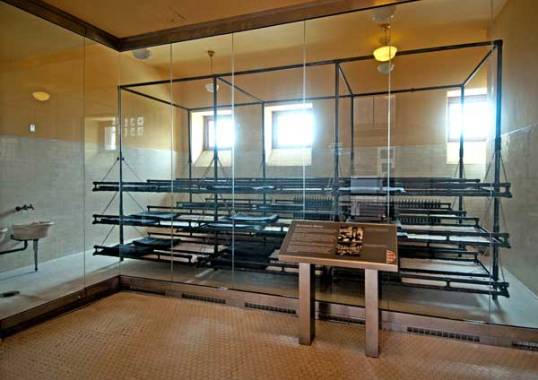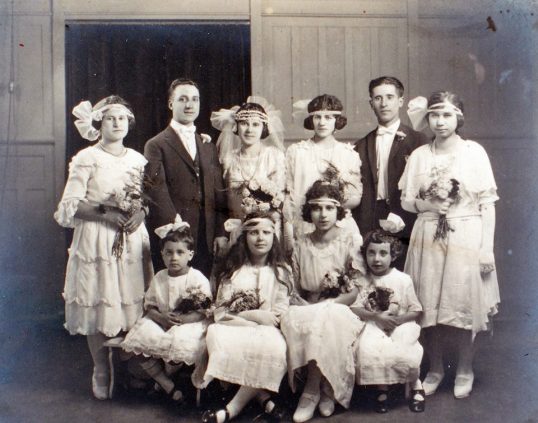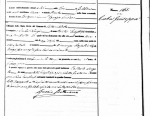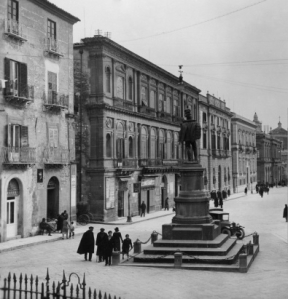 Being 100% of Italian descent, I don’t have a drop of Irish blood. But my husband and children do.
Being 100% of Italian descent, I don’t have a drop of Irish blood. But my husband and children do.
My husband’s 3X great grandmother, Jane Shaw Downey was born April 30, 1824 in Londonderry, Ireland. Her parents were Sarah Shaw, born in Ireland, and Robert Downey, born in Ireland. Jane immigrated to the United States in 1844 and married John Charles Waelde, a potter, on May 6, 1850 in Ithaca, Tompkins, New York, United States.
North Bay Pottery
A rich deposit of clay near mill stream attracted potters to North Bay in New York. In the mid 1800s, potters settled in North Bay, attracted by the abundance of clay, wood and water. German craftsman, John C. Waelde, produced stoneware through 1875. John C. Waelde’s pottery was popular because of its hand painted and stenciled artwork. Many of John’s pottery jugs still exist and bring a pretty penny at auction.
Jane and John had nine children:
Sarah Jane, born 24 March 1851 and died in 1930
Erwin Robert, born 26 July 1852 and died 29 April 1940
Julia Elizabeth, born 21 August 1854 and died 6 February 1955
Mary Ann, born 6 July 1856 and died 20 December 1887
Helena born 1 November 1858 and died 8 September 1861 (only age 2)
Emma Louise, born 8 December 1860 and died 16 September 1945
Charles Henry, born 18 May 1863 and died 26 December 1916
Anna Emile, born 7 January 1866 and died 17 November 1936
William Howard, born 12 March 1870 and died 27 August 1889
On the 1860 Federal Census, John and Jane were living in the Town of Vienna, Oneida County, New York, North Bay Post Office. Sarah Downing, Jane’s mother, was living with them.
In the 1875 New York census, John and Jane were living in Vienna, Oneida county, New York. John was employed as a potter and was a Naturalized citizen. They lived with their 7 children, Sarah, Julia, Mary, Emma, Charles, Anna and Willie. Sarah (age 24), Julia (age 20) and Mary (age 12) all worked as weavers at a cotton factory in New York Mills.
On the 1880 U.S. Federal Census, Jane is listed as head of household and married. John is not listed as living with them. I can’t find John in any census records from 1880. She and her children (Emma, Charles, Anna and William) were living in Vienna, Oneida, New York. Also, the children list their father’s birth place as Wurttemberg, Germany.
In the 1892 New York census, John is back living with Jane and their daughter Anna in Maryland Township, Otsego County, New York. John’s occupation was listed as Potting Ware.
According to the 1900 federal census, John C. Waelde and wife, Jane, lived in Maryland Township, Otsego County, New York. John’s birth date was listed as August 1819 and Jane’s was listed as April 1830. Jane indicated that she had 9 children, 6 of which are still living. John said he was born in Germany and his parents were both born in Germany. Jane said she was born in Ireland and her parents were both born in Ireland. John said he came to the U.S. in 1847 and Jane immigrated in 1844. John is listed as blind.
Jane died 16 March 1914. She was preceded in death by John, who passed away in 1903.
From the Syracuse Herald, 17 March 1914, page 4
Mrs. Jane Waelde – North Bay Woman of 90 Years Died at Daughter’s Home
North Bay, March 17 – At the home of her daughter, Mrs. Sarah Brown, on Main street, yesterday morning occurred the death of Mrs. Jane Waelde. Last fall she came here to spend the winter with her daughter and until several weeks ago she was in her usual health. Her maiden name was Jane S. Downey and she was born in Londonberry, Ireland. Had she lived until April 16th she would have been ninety years old. Her marriage to John C. Waelde took place May 6th 1850 and for twenty years they resided here leaving here in the spring of 1881 to make their home in Schenevus.
She leaves six children, Mrs. Sarah Brown of North Bay, Mrs. Julia Palma of Durhamville, Mrs. Emma Mason of Newport, KY, Mrs. Anna Earing of Maple Valley, Erwin R. Waelde of Poughkeepsie and Charles Waelde of Newburgh, also several grandchildren and great-grandchildren. The funeral (not legible) Mrs. Brown at 1 o’clock this afternoon, the Rev F. J. Fulton officiating and tomorrow morning the body will be taken to Schenevus, Otsego county and laid to rest beside her husband.
Posted in
family,
family history,
family photos,
family tree,
genealogy and tagged
#familyhistory,
52 Ancestors Challenge 2015,
52 Ancestors in 52 Weeks,
family photos,
family tree,
genealogy,
Ireland,
Irish,
Jane Shaw Downey,
John C. Waelde,
John Charles Waelde |






 Concetta Abbate was born May 2, 1858 in Villarosa, Sicily, Italy to Ignazio Abbate and Rose Vitale. She married Angelo Fiandaca on September 8, 1881 when she was 23 years old. Angelo was 33 and a widower with at least two children. Concetta and Angelo had three children – Ignacio born in 1888, Guiseppe born in 1890 and Rose born in 1893. Angelo died on April 17, 1910 in Villarosa.
Concetta Abbate was born May 2, 1858 in Villarosa, Sicily, Italy to Ignazio Abbate and Rose Vitale. She married Angelo Fiandaca on September 8, 1881 when she was 23 years old. Angelo was 33 and a widower with at least two children. Concetta and Angelo had three children – Ignacio born in 1888, Guiseppe born in 1890 and Rose born in 1893. Angelo died on April 17, 1910 in Villarosa.





You must be logged in to post a comment.